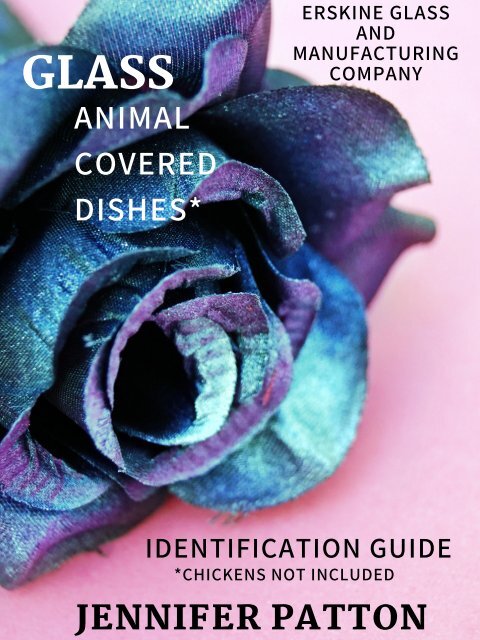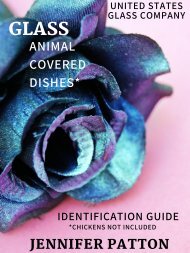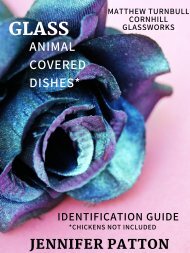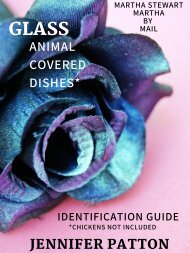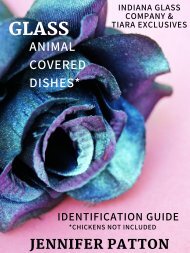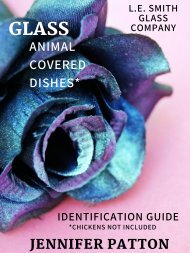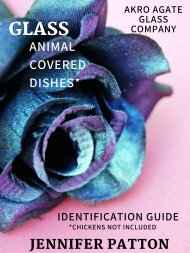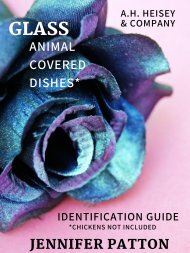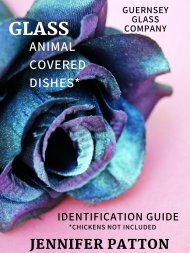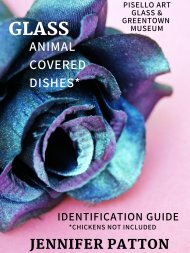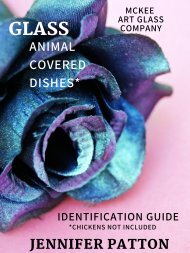Erskine Glass and Manufacturing Co
You also want an ePaper? Increase the reach of your titles
YUMPU automatically turns print PDFs into web optimized ePapers that Google loves.
GLASS<br />
ERSKINE GLASS<br />
AND<br />
MANUFACTURING<br />
COMPANY<br />
ANIMAL<br />
COVERED <br />
DISHES*<br />
IDENTIFICATION GUIDE<br />
*CHICKENS NOT INCLUDED<br />
<br />
JENNIFER PATTON
ABOUT ME<br />
Hi! My name is Jen <strong>and</strong> this is a little bit about myself. First, I must say this project was a lot of fun.<br />
Like a book from my gradeschool years lol. I don’t know if children today still do book reports, but when<br />
I was in school, they were required <strong>and</strong> boy did I dread reading the assigned books then having to<br />
summarize them! I loved reading books that interested me <strong>and</strong> hopefully this will interest you. I created<br />
it for anyone that needs help with identification. For the novice glass collectors that buy animal covered<br />
dishes because they fall in love with the way they look or the type of animals they are, or simply for<br />
their colors. For the avid collectors who enjoy buying a few of each animal regardless of the maker. For<br />
the veteran collectors who may have hundreds of glass dishes who never cease to amaze me with their<br />
beautiful collections. For the people that have inherited or purchased someone’s entire collection or<br />
part of a collection <strong>and</strong> need help to identify things. For the people like me that are meticulous about<br />
every detail needing to label things <strong>and</strong> just absolutely need to know the whats, whens, whos, hows <strong>and</strong><br />
whys of the animal dishes they own. For me, what started with one Asian yellow stained glass bunny on<br />
a nest, has flourished into a full blown collection of hundreds of mixed <strong>and</strong> matched animal covered<br />
“c<strong>and</strong>y” dishes of all glass types <strong>and</strong> colors. No particular glass maker, just everything I can’t live<br />
without. LOL. Anyone that knows me would tell you that I stop at nothing, studying book after book<br />
searching for answers about my own glass animals until I find them. I have never been satisfied with a<br />
mystery….unless it involves me watching <strong>Co</strong>lumbo, my lifelong favorite television program! I am a<br />
mystery solver... a true detective. I get this from my Mother, Cindy -Sultana- Wheatley. I need to get to<br />
the bottom of a piece of unidentified glass. It drives me bananas not to know everything I can about<br />
each piece that I own. Next, I will tell you that the monetary value of my glassware means nothing to<br />
me. I collect it because I love it. However, unique <strong>and</strong> rare is always a find! Sure, like every collector, I<br />
love a bargain <strong>and</strong> have had to pass up many pieces that I could not afford. Ooooh the ones that got<br />
away. They haunt me. I can assure you that when I get a new addition to my collection, it has found its<br />
forever home. Someone before me <strong>and</strong> usually possibly before them owned these animal covered<br />
dishes making a kind of history that I can only imagine in my mind, its importance to each person. There<br />
is a reason behind every single glassware in every single dwelling. <strong>Glass</strong> symbolizes many things. It is<br />
proudly displayed. It is important to the person who owns it. I enjoy seeing the happiness glassware<br />
brings to people, especially these animal covered dishes. Who doesn’t love animals? I also enjoy seeing<br />
my collection knowing these pieces of history live on <strong>and</strong> hope that when I am long gone, they will be in<br />
other homes. My glass brings me peace; most peaceful in the evenings when the cabinet lights are on<br />
<strong>and</strong> the glass does its natural thing; what it was intended to do since the day it was made...look pretty! <br />
To me, it is reminiscent of having a year round Christmas Tree. <strong>Glass</strong> is AMAZING! I am a country girl<br />
through <strong>and</strong> through. I love all things nature. I am an avid bird watcher <strong>and</strong> an all around animal lover. I<br />
live in the beautiful state of Kentucky with my husb<strong>and</strong> <strong>and</strong> our two dogs, Monkey <strong>and</strong> Johnnie, who by<br />
the way, is named after my all time favorite singer, Johnny Cash.
<strong>Glass</strong> Animal <strong>Co</strong>vered Dishes © Jennifer Patton<br />
glass animal covered dishes<br />
by Jennifer Patton<br />
ERSKINE GLASS AND<br />
MANUFACTURING CO.<br />
copyright © 2022 by Jennifer Patton<br />
All rights reserved. No parts of this work may be reproduced without<br />
written permission from the copyright holder.<br />
No parts of this work may be reproduced for financial gain by anyone<br />
other than the copyright holder.
<strong>Erskine</strong> glass & <strong>Manufacturing</strong> company<br />
<strong>Erskine</strong> was an illuminating glass company. Not much has been spoken<br />
about <strong>Erskine</strong> <strong>Glass</strong> & MFG <strong>Co</strong>. of Wellsburg W.V. Steubenville, OH natives:<br />
John O <strong>Erskine</strong> <strong>and</strong> William <strong>Erskine</strong> <strong>and</strong> Pittsburgh, PA natives: J.G.<br />
Simpon, Robert S. Cain <strong>and</strong> D.S. Swaney formed the company. <strong>Erskine</strong><br />
<strong>Glass</strong> & MFG <strong>Co</strong> began in Steubenville, OH on June 20, 1919. The company<br />
was relocated to Wellsburg, WV <strong>and</strong> would remain there until it closed its<br />
doors in 1975. Brooke <strong>Co</strong>unty (Wellsburg, WV) was rich in glass history <strong>and</strong><br />
once had over 30 glass factories including Riverside. <strong>Erskine</strong> glass factory<br />
was located at 22nd St. <strong>and</strong> Yankee St. in the old Dalzell glass factory. 99%<br />
of early glassware produced by <strong>Erskine</strong> was lighting, lamps, lamp globes<br />
<strong>and</strong> lamp shades in Crystal <strong>and</strong> White Milk <strong>Glass</strong>. Later, they produced h<strong>and</strong><br />
painted milk glass bells <strong>and</strong> ashtrays <strong>and</strong> colorful lamp globes <strong>and</strong> animal<br />
covered dishes. In 1934, when <strong>Co</strong>-Operative Flint <strong>Glass</strong> <strong>Co</strong>mpany shut<br />
down, <strong>Erskine</strong> acquired their Frog, 7" dome lidded Elephant, <strong>and</strong> Walking<br />
Bear molds. They produced Turtle ACDs 1920's-1930's / Bear, Elephant, <strong>and</strong><br />
Frog ACDs in the 1930's / Frog <strong>and</strong> Elephant ACDs again 1960's-1970's. As<br />
for the Bear, <strong>Erskine</strong> got the mold because it appeared on L.G. Wright's<br />
inventory list of 1938. <strong>Erskine</strong> sold glass to Wright from 1937-'38. The <strong>Co</strong>-op<br />
Bear mold would be donated to the WWII Iron Scrap drive by 1941.<br />
Questions... "Did <strong>Erskine</strong> also acquire the Whale mold? Where was the <strong>Co</strong>-<br />
op Whale mold between 1934-1941? Why didn't <strong>Erskine</strong> reproduce it? It was<br />
also lost to the scrap drive. Where were the <strong>Co</strong>-op Cat <strong>and</strong> Dog molds?<br />
Where were the other lids to the small Elephant? We know the Frog <strong>and</strong><br />
Small Elephant with domed lid molds survived the scrap drive because<br />
<strong>Erskine</strong> reproduced both after the scrap drive using original <strong>Co</strong>-op molds.<br />
Between the 1938 <strong>and</strong> 1960's, <strong>Erskine</strong><br />
lost or damaged the Elephant lid mold.<br />
Later produced <strong>Erskine</strong> Elephants have<br />
newly created lids.<br />
It is not known where <strong>Erskine</strong> got<br />
the Turtle mold.<br />
<strong>Erskine</strong> did not purchase the Cat or<br />
Dog molds from <strong>Co</strong>-Operative Flint. Label found on later-made<br />
<strong>Erskine</strong> animal covered dishes<br />
© <strong>Glass</strong> Animal <strong>Co</strong>vered Dishes by Jennifer Patton<br />
Page 1
© <strong>Glass</strong> Animal <strong>Co</strong>vered Dishes by Jennifer Patton<br />
Page 2<br />
<strong>Erskine</strong> glass & <strong>Manufacturing</strong> company<br />
The Bear mold was scrapped. The Whale mold was scrapped. <strong>Erskine</strong><br />
probably never owned the Whale mold. The Elephant mold went to<br />
Wheaton Industries, then to Indiana <strong>Glass</strong> <strong>Co</strong>mpany. It is not known where<br />
the Frog mold went. The Turtle mold ended up with Si Wright <strong>and</strong> later<br />
went to the National Milk <strong>Glass</strong> <strong>Co</strong>llector's Society.<br />
<strong>Erskine</strong> <strong>Glass</strong> <strong>and</strong> <strong>Manufacturing</strong> <strong>Co</strong>mpany closed its doors in 1975, but was<br />
officially deemed out of business May 18, 1983, dissolution by court order.<br />
Brooke <strong>Co</strong>unty in West Virginia was rich in glass history. You may visit the<br />
Brooke <strong>Co</strong>unty Historical Museum <strong>and</strong> Cultural Center located in<br />
Wellsburg, WV. to learn more.
<strong>Erskine</strong> glass & Mfg <strong>Co</strong>. BEAR<br />
<strong>Erskine</strong> <strong>Glass</strong> & <strong>Manufacturing</strong> <strong>Co</strong>mpany Bear is a reproduction of the<br />
original <strong>Co</strong>-Operative Flint <strong>Glass</strong> Walking Bear. <strong>Co</strong>-op produced the Bear<br />
1927-1931. <strong>Erskine</strong> bought the mold in 1934 when <strong>Co</strong>-op went out of<br />
business. It is not known which Bear colors were produced by <strong>Erskine</strong>,<br />
but it was indeed made by <strong>Erskine</strong>. At the very least, <strong>Erskine</strong> poured 3<br />
dozen Bears for L.G. Wright in 1937-'38. Wright's inventory listed 3 dozen<br />
Bears. <strong>Erskine</strong> <strong>Glass</strong> & MFG <strong>Co</strong> sold animal covered dishes to Si Wright. <br />
The Bear mold was later donated to the WWII Iron Scrap Drive before<br />
1941. Bear is unmarked. 8" long.<br />
I had no <strong>Erskine</strong> Bear photos to show.<br />
© <strong>Glass</strong> Animal <strong>Co</strong>vered Dishes by Jennifer Patton<br />
Page 3
© <strong>Glass</strong> Animal <strong>Co</strong>vered Dishes by Jennifer Patton<br />
Page 4<br />
frog DISH by UNKNOWN MAKER<br />
Unknown maker reproduction Frog of the Vallerysthal 1894-1908 #3769<br />
Frog surfaced ca. 1915-1925. It was only in Pastel Green iridescent. The<br />
unknown Frog maker is where <strong>Co</strong>-Operative Flint may have acquired the<br />
mold. Frog dish was reproduced by <strong>Co</strong>-Op 1927-1930's <strong>and</strong> by <strong>Erskine</strong><br />
<strong>Glass</strong> & MFG. <strong>Co</strong>. 1934/'37-1938 <strong>and</strong> 1960's-1970's. <strong>Erskine</strong> acquired the<br />
<strong>Co</strong>-Operative Flint Frog mold in 1934.<br />
Following excerpt is pg. 108 from Marion Hartung's book via an online<br />
site: https://www.hookedoncarnival.com<br />
"Many of the covered animal dishes in CARNIVAL GLASS are known in<br />
only one color. This is true of the small frog shown here. Since that color<br />
happens to be a PASTEL GREEN in this case, nothing could be more<br />
appropriate. One can hardly imagine a bright orange frog, even though<br />
realism was not considered essential to the makers of IRIDESCENT<br />
GLASS.<br />
This perky little fellow is of medium weight glass, HIGHLY IRIDESCENT<br />
with the PASTEL-TYPE of coloring we have learned to associate with<br />
pieces having been made on a PASTEL SHADE OF BASE GLASS. The<br />
interior of the figure seems to have even more of the IRIDESCENCE than<br />
does the outside. The bulging glass EYES ARE MOLDED in with the rest of<br />
the figure, <strong>and</strong> simply have BLACK PAINT APPLIED to make the contrast.<br />
Honesty compels us to admit that we are not overly familiar with frogs<br />
as such, but the detail here seems good to us, <strong>and</strong> the general effect<br />
seems realistic.<br />
The piece st<strong>and</strong>s 4 inches high at the tallest point, <strong>and</strong> measures 5<br />
1/2" in length. Search as we will, the maker is unknown. This would be<br />
quite a desirable addition to any collection of CARNIVAL GLASS animal<br />
shapes. IT WOULD CERTAINLY MAKE A FINE COMPANION PIECE FOR THE<br />
COVERED TURTLE SHOWN IN OUR BOOK 5."-----Marion T. Hartung
frog DISH BY UNKNOWN MAKER<br />
The example frog shared to Hartung's book was courtesy of Mr. <strong>and</strong> Mrs.<br />
De Layne Eigenberg of Fairbury, Nebraska. Like the matching Turtle in<br />
Hartung's Book 5, parts of the Frog were painted black.<br />
I have seen a h<strong>and</strong>ful of Pastel Green Iridescent Frogs online for sale. The<br />
bases are marked but I do not recognize the maker's mark.<br />
You may view one here:<br />
https://www.worthpoint.com/worthopedia/vintage-frosted-satin-green-<br />
glass-1901990829<br />
<strong>and</strong> here:<br />
https://www.ddoty.com/coveredfrog.html<br />
This is the mark seen on Pastel Green<br />
Iridescent Frogs with painted black eyes.<br />
Appears to be H i<br />
© <strong>Glass</strong> Animal <strong>Co</strong>vered Dishes by Jennifer Patton<br />
Page 5
© <strong>Glass</strong> Animal <strong>Co</strong>vered Dishes by Jennifer Patton<br />
Page 6<br />
<strong>Erskine</strong> glass & Mfg <strong>Co</strong>. frog<br />
<strong>Erskine</strong> <strong>Glass</strong> & <strong>Manufacturing</strong> <strong>Co</strong>mpany Frog is a reproduction of the<br />
original <strong>Co</strong>-Operative Flint <strong>Glass</strong> #548 Frog Jar. <strong>Co</strong>-op produced the Frog<br />
1927-1931. <strong>Erskine</strong> bought the mold in 1934 when <strong>Co</strong>-op went out of<br />
business. In 1937-1938, <strong>Erskine</strong> poured the Frog <strong>and</strong> sold 2 dozen Frogs to<br />
L.G. Wright. They may have sold more to Wright, but we can only prove what<br />
Wright's 1938 Inventory showed, 2 dozen. The colors produced for Wright are<br />
not known. Between 1960's-1970's, <strong>Erskine</strong> produced the Frog again in these<br />
colors: Dark Amber (Beer Bottle), Black Milk <strong>Glass</strong>, Crystal, Crystal Satin,<br />
Green, Olive Green, Smoke, Pink <strong>and</strong> White milk glass. Other colors possible.<br />
Early <strong>Erskine</strong> Frogs for Wright were unmarked. Later <strong>Erskine</strong> Frogs were<br />
marked with Red/Gold foil labels which read <strong>Glass</strong> by <strong>Erskine</strong> Wellsburg<br />
W.VA.<br />
Because this Frog was produced using the original <strong>Co</strong>-Op mold, mutual<br />
colors in Green <strong>and</strong> Pink are difficult to ID. Unless <strong>Erskine</strong> labels are still<br />
present, one would need to view <strong>Co</strong>-Op <strong>and</strong> <strong>Erskine</strong> Frogs side by side to see<br />
a difference in colors. <strong>Co</strong>-Op produced higher quality glass.<br />
<strong>Erskine</strong> Frog is 5 1/2" long.<br />
I had no <strong>Erskine</strong> Frog photos to share.
<strong>Erskine</strong> glass & Mfg co. elephant<br />
<strong>Erskine</strong> <strong>Glass</strong> & MFG <strong>Co</strong>. Elephant is a reproduction of the original 7 1/2"<br />
<strong>Co</strong>operative Flint <strong>Glass</strong> Dome lidded #554 Elephant 1927-1930's. <strong>Erskine</strong><br />
bought the small Elephant mold in 1934 when <strong>Co</strong>-Op Flint closed. <strong>Erskine</strong><br />
was primarily an illuminating company, making lights <strong>and</strong> light fixtures so<br />
the Elephant covered dish may come as a surprise. <strong>Erskine</strong> first produced<br />
the Elephant after 1934 <strong>and</strong> also sold to L.G. Wright in 1937/'38. The 1938 L.G.<br />
Wright inventory listed 3 dozen Elephants on h<strong>and</strong>. Because <strong>Erskine</strong> animal<br />
covered dishes never appeared in any of Wright's photos/ads/catalogs, it is<br />
not known which Elephant colors Wright purchased from <strong>Erskine</strong>. It is not<br />
known how many more than 36 were made for Wright, but my guess is none<br />
were produced after the <strong>Erskine</strong> Turtle mold disappeared. Wright/<strong>Erskine</strong><br />
communications probably ended after the Turtle mold was not returned.<br />
Fenton Art <strong>Glass</strong> began to pour glass for L.G. Wright around the same time,<br />
1938.<br />
The Elephant mold survived the WWII iron scrap drive. Later <strong>Erskine</strong><br />
Elephants made 1969-1970's were produced in Dark Amber (Beer bottle),<br />
Black Milk <strong>Glass</strong>, Crystal, Pink, Green, Olive Green, Smoke <strong>and</strong> White Milk<br />
<strong>Glass</strong>. Other colors possible. Over the many years, the lid molds were lost or<br />
broken. Later Elephants have replacement lids.<br />
<strong>Erskine</strong> Elephants are unmarked. Elephants made for Wright were not<br />
labeled. Later Elephants made 1969-1970's had Red/Gold foil labels which<br />
read <strong>Glass</strong> by <strong>Erskine</strong> Wellsburg W.VA. Label may still be present. 7 1/2" long.<br />
Elephant mold went to Wheaton Industries<br />
around 1980/'81. Wheaton could not<br />
produce the Elephant Dish nor could they<br />
open the mold properly.<br />
Indiana <strong>Glass</strong> <strong>Co</strong>mpany got the mold<br />
from Wheaton. Indiana produced the<br />
Elephant Dish for themselves in 1981.<br />
Indiana produced the Elephant Dish for<br />
Tiara Exclusives 1983-'87.<br />
This label is found on<br />
Fenton acquired the mold after 2002.<br />
<strong>Erskine</strong> Elephants<br />
Fenton never reproduced the Elephant Dish.<br />
© <strong>Glass</strong> Animal <strong>Co</strong>vered Dishes by Jennifer Patton<br />
Page 7
© <strong>Glass</strong> Animal <strong>Co</strong>vered Dishes by Jennifer Patton<br />
Page 8<br />
<strong>Erskine</strong> glass & Mfg <strong>Co</strong>. elephant<br />
Photos taken from:<br />
https://magwv.pastperfectonline.com/Webobject/2AF75DDB-81A3-4C28-9849-<br />
561233044194<br />
<strong>Co</strong>urtesy of MAGWV, Museum of American <strong>Glass</strong> of West Virginia
© <strong>Glass</strong> Animal <strong>Co</strong>vered Dishes by Jennifer Patton<br />
Page 9<br />
tURTLE DISH by UNKNOWN MAKER<br />
An early reported <strong>Co</strong>vered "Knobby Back" Turtle Dish in an atypical color<br />
was shared by a couple from Indianapolis, Indiana. The following<br />
excerpt is from pg 105 of Marion Hartung's book via an online site:<br />
https://www.hookedoncarnival.com<br />
"Mr. <strong>and</strong> Mrs. Herb Ripley of Indianapolis, Indiana, have graciously<br />
shared this treasure from their collection with us. Their pet name for him<br />
is "Old Mossback", <strong>and</strong> the lovely SHIMMERING PASTEL GREEN OF<br />
WHICH HE IS MADE, makes the title more than fitting. Either at the time<br />
he was made or somewhere along the line, his HEAD, TAIL AND FEET<br />
HAVE BEEN PAINTED BLACK. But rather than detracting from the general<br />
effect, this only seems to contrast nicely with the IRIDESCENCE.<br />
The back of the turtle, patterned here in a most realistic design, lifts<br />
off <strong>and</strong> is light in weight. Except for the cavity under this lid, all of the<br />
rest of the animal is of solid glass. This makes it a very heavy piece,<br />
usable as a door-stop as well as c<strong>and</strong>y dish.<br />
He is of generous size, being nine <strong>and</strong> one-half inches long, <strong>and</strong><br />
st<strong>and</strong>ing about four inches tall to the top of the back.<br />
Truly this must be considered one of the rarities of CARNIVAL GLASS.<br />
Although his maker is quite unknown, the general era is of the late 'teens<br />
or early twentys, so far as we now know." ----The Ripleys<br />
The pastel Green iridescent Turtle with Black paint is by an unknown<br />
maker. However, there is a matching Frog which is marked <strong>and</strong> is a<br />
reproduction of the original Vallerysthal 1894-1908 #3769 Frog. This<br />
unknown Frog maker ca. 1915-1925 is where <strong>Co</strong>-Operative Flint may<br />
have acquired the Frog mold. The Frog dish was reproduced by <strong>Co</strong>-Op<br />
1927-1930's <strong>and</strong> then by <strong>Erskine</strong> <strong>Glass</strong> & MFG. <strong>Co</strong>. 1937-1938 <strong>and</strong> 1960's-<br />
1970's.
© <strong>Glass</strong> Animal <strong>Co</strong>vered Dishes by Jennifer Patton<br />
Page 10<br />
<strong>Erskine</strong> glass & Mfg <strong>Co</strong>. Turtle Dish<br />
This information is VERY IMPORTANT, or at least I think it is... I came across<br />
an online sales record on Worthpoint which was labeled as "RARE 1920'S<br />
ERSKINE GLASS COVERED TURTLE DISH ~ MILK-WHITE OPAQUE ~" <strong>and</strong> I put it<br />
on the back burner, never thinking anymore about it. BUT! while working on<br />
<strong>Erskine</strong> Elephants, I came across a second Worthpoint post, this time labeled<br />
as "RARE 1927 ERSKINE GLASS COVERED TURTLE DISH WELLSBURG WV MILK<br />
GLASS & CLEAR". Then I was intrigued! I had been searching for the missing<br />
link between <strong>Erskine</strong> Elephants <strong>and</strong> LG Wright <strong>Glass</strong> <strong>Co</strong>mpany <strong>and</strong> had found<br />
another Wright animal covered dish <strong>and</strong> again, <strong>Erskine</strong> <strong>Glass</strong> & MFG <strong>Co</strong> name<br />
appeared? So, going further down the hypothetical glass research "rabbit<br />
hole", I couldn't ignore this second Worthpoint post. Fact: The Turtle Dish<br />
was made in both Milk <strong>Glass</strong> <strong>and</strong> Crystal because of the mismatched lid. Fact:<br />
There was a note inside the Turtle Dish from the owner showing provenance<br />
of the Dish. Fact: The original owner simply did not get her own Wedding Day<br />
date wrong. Fact: <strong>Erskine</strong> <strong>Glass</strong> & MFG <strong>Co</strong>. produced both Crystal <strong>and</strong> White<br />
Opaque (milk glass). Fact: <strong>Erskine</strong> <strong>Glass</strong> & MFG <strong>Co</strong> loaned out the Turtle mold<br />
to someone <strong>and</strong> it was claimed to be "lost" <strong>and</strong> never returned. Fact: 1937<br />
L.G. Wright invoice proved that Wright had 4 dozen turtles on h<strong>and</strong>. Fact:<br />
Fenton poured the Knobby Back Turtle mold for L.G Wright 1937-1940's.<br />
It appears that Mr. Wright or one of his associates took the Turtle mold. But<br />
how did he pull it off? The owner <strong>and</strong> maker of this Turtle Dish was <strong>Erskine</strong>.<br />
This note states: "Made at the<br />
<strong>Erskine</strong> <strong>Glass</strong> + <strong>Manufacturing</strong> co.<br />
Wellsburg W.V. in 1927. Given to<br />
me as a wedding gift Sept 2, 1927<br />
Cecil <strong>and</strong> Nona Garretson of<br />
Wellsburg W.V"<br />
Either the married couple were<br />
the Garretsons or the people who<br />
gifted the 1927 Turtle were the<br />
Garretsons. Either way, they lived<br />
in Wellsburg, W.V <strong>and</strong> would have<br />
been totally aware of where they purchased the Turtle; <strong>Erskine</strong> <strong>Glass</strong> of Wellsburg, W.V.<br />
My point here is how very important the provenance of unmarked glass animal covered<br />
dishes is. This note alone was written 10 years before L.G. Wright <strong>Glass</strong> <strong>Co</strong>mpany was<br />
formed in 1936-'37. Fun fact: Wright <strong>Glass</strong> <strong>Co</strong>mpany was only 54 miles from <strong>Erskine</strong>.
© <strong>Glass</strong> Animal <strong>Co</strong>vered Dishes by Jennifer Patton<br />
Page 11<br />
<strong>Erskine</strong> glass & Mfg <strong>Co</strong>. turtle dish<br />
It is not known where <strong>Erskine</strong> got the Turtle mold. It was not part of the 1934<br />
acquisition of <strong>Co</strong>-op ACDs. Original <strong>Co</strong>-Op molds plus the Turtle ALL appeared<br />
on the 1938 L.G. Wright Inventory list:<br />
4 dozen Turtles, 3 dozen Elephants, 3 dozen Bears, 2 dozen Frogs<br />
These were poured by <strong>Erskine</strong> <strong>and</strong> purchased by Wright. This was common<br />
practice of Si Wright, to travel to glass factories <strong>and</strong> order a few pieces here<br />
<strong>and</strong> there to resell.<br />
<strong>Erskine</strong> poured the Turtle in White Milk <strong>Glass</strong> <strong>and</strong> Crystal. I also believe <strong>Erskine</strong><br />
produced the **hard-to-find** Pink Turtles. Pink was a color <strong>Erskine</strong> produced<br />
using original <strong>Co</strong>operative Flint molds, i.e.: Pink Elephants, Pink Frogs <strong>and</strong><br />
possibly Pink Bears.<br />
It is my opinion White Milk <strong>Glass</strong> Turtles which we have been attributing as<br />
poured-by-Westmorel<strong>and</strong>-<strong>Co</strong>mpany-in-the-1980's-for-L.G. Wright-using-<br />
Wright's-mold could have been poured by <strong>Erskine</strong> 1920-1927, 10 years before<br />
L.G Wright formed his glass company. Meaning: the 1920's Turtles by <strong>Erskine</strong><br />
were marketed for themselves. <strong>Erskine</strong> would have been producing the Turtle,<br />
Bear, Elephant <strong>and</strong> Frog <strong>and</strong> in 1937, while Si Wright traveled in search of glass<br />
ideas, he fancied the Turtle dish <strong>and</strong> ordered 4 dozen made in White Milk<br />
<strong>Glass</strong>. He also ordered 3 dozen Elephants, 2 dozen Frogs <strong>and</strong> 3 dozen Bears. I<br />
could not find which Elephant, Frog <strong>and</strong> Bear colors Wright purchased from<br />
<strong>Erskine</strong>. Wright did not own these original <strong>Co</strong>operative Flint molds. <strong>Erskine</strong><br />
did.<br />
---After 1937, Fenton poured White milk glass Turtles for Wright---<br />
---Both <strong>Erskine</strong> <strong>and</strong> Fenton poured White---<br />
You may view the Worthpoint sales posts:<br />
Type in <strong>Erskine</strong> Turtle on www.worthpoint.com
<strong>Erskine</strong> glass & Mfg <strong>Co</strong>. turtle dish<br />
After 1937, Fenton poured the Knobby Back Turtle for L.G. Wright in Crystal,<br />
light Amber, dark Amber, Emerald Green, <strong>and</strong> White milk glass. Never in Pink<br />
transparent. Wright had 48 turtles on his 1938 inventory list. Meaning: Si Wright<br />
now had possession of the Turtle mold. Remember! <strong>Erskine</strong> said they loaned it<br />
out <strong>and</strong> the mold was never returned. Si Wright was who it was loaned out to.<br />
He took it to Fenton. I believe this was when Wright had his opportunity to<br />
"claim <strong>and</strong> keep" the Turtle mold as his own, while it was at the Fenton glass<br />
factory. Fenton poured the Turtle for years for Wright. Si Wright went on to<br />
"own" the Turtle mold for the rest of his life <strong>and</strong> much longer. In 1983/'84,<br />
Westmorel<strong>and</strong> poured the Turtle mold in Chocolate Milk <strong>Glass</strong> for L.G. Wright<br />
using Wright's mold. Historically, Si Wright had molds reworked; even re-<br />
created. Circumstantial evidence may prove this was not the case with the<br />
Turtle. Timing <strong>and</strong> execution were perfect. Motive would have been present.<br />
The Turtle dish is a one-of-a-kind beautiful ACD. It is one of my favorite pieces!<br />
<strong>Erskine</strong> Turtle Dish is unmarked. Heads may have drooped during the cooling<br />
process causing gaps where lids meet bases. Some heads may be straighter.<br />
This would have been caused by glassworkers' h<strong>and</strong>ling. 11" long.<br />
The Turtle mold was reproduced by L.G. Wright between 1937-1983/'84.<br />
<strong>Glass</strong> was poured by Fenton <strong>and</strong> Westmorel<strong>and</strong> <strong>Glass</strong>. Wright had<br />
possession of the mold.<br />
Photos by Denise Brouillette, Marian Lanchman <strong>and</strong> Jennifer Patton<br />
© <strong>Glass</strong> Animal <strong>Co</strong>vered Dishes by Jennifer Patton<br />
Page 12
© <strong>Glass</strong> Animal <strong>Co</strong>vered Dishes by Jennifer Patton<br />
Page 13<br />
erskine glass & manufacturing company<br />
BIBLIOGRAPHY: <strong>Erskine</strong> <strong>Glass</strong> & MFG <strong>Co</strong>:<br />
Book: The L.G. Wright <strong>Glass</strong> <strong>Co</strong>mpany by James Measell <strong>and</strong> W.C "Red"<br />
Roetteis, published by The <strong>Glass</strong> Press, Inc. dba Antique Publications,<br />
copyright 1997, Page 11- 1938 INVENTORY LIST, Pages 10-12 -ERSKINE<br />
FOR WRIGHT ANIMAL COVERED DISHES<br />
Online: www.ndga.net/rainbow/1976/76rrg09d.php - National<br />
Depression <strong>Glass</strong> Association article "<strong>Glass</strong> <strong>Co</strong>vered Frog & Elephant<br />
items" by Mary Van Pelt, Rainbow Review <strong>Glass</strong> Journal - September<br />
1976-LOST TURTLE MOLD<br />
<strong>Co</strong>rrespondence: with Tom Felt of MAGWV-PHOTO<br />
Online: https://www.theintelligencer.net/life/features/2019/07/theres-<br />
always-something-new-in-antiques/ July 14, 2019 article in Wheeling<br />
News-Register "There's Always Something New in Antiques" by Maureen<br />
Zambito-HISTORY<br />
Online: https://cmog.primo.exlibrisgroup.com/discovery/fulldisplay?<br />
vid=01CORNING_INST:01CORNING_INST&DOCID=ALMA99526943504126<br />
&context=L&virtualBrowse=true -CATALOGS<br />
Online: https://www.worthpoint.com -LINKS TO TURTLE PHOTOS<br />
Book: Fenton <strong>Glass</strong> Made for Other <strong>Co</strong>mpanies 1907-1980 by Carrie <strong>and</strong><br />
Gerald Domitz, published by <strong>Co</strong>llector Books a division of Schroeder<br />
Publishing <strong>Co</strong>., Inc., copyright 2005 by Carrie <strong>and</strong> Gerald Domitz, Page<br />
164-TURTLE COLORS POURED BY FENTON FOR WRIGHT<br />
Book: Eighth Book of Carnival <strong>Glass</strong>, First Edition, Second Printing 1968,<br />
by Marion T. Hartung, Page 108 -Frog description by Mr. <strong>and</strong> Mrs. De<br />
Layne Eigenberg from Fairbury, Nebraska -FROG, UNKNOWN MAKER<br />
Online: www.hookedoncarnival.com: Direct weblink:<br />
https://www.hookedoncarnival.com/wp-<br />
content/uploads/library/Marion%20T.%20Hartung%20-<br />
%20Eighth%20Book%20Carnival%20<strong>Glass</strong>.pdf -FROG IN PASTEL GREEN<br />
IRIDESCENT PAGE 108 FROM HARTUNG BOOK
© <strong>Glass</strong> Animal <strong>Co</strong>vered Dishes by Jennifer Patton<br />
Page 14<br />
erskine glass & manufacturing company<br />
BIBLIOGRAPHY: <strong>Erskine</strong> <strong>Glass</strong> & MFG <strong>Co</strong>:<br />
Online: www.hookedoncarnival.com: Direct weblink:<br />
https://www.hookencarnival.com/wp-<br />
content/uploads/library/Marion%20T.%20Hartung%20-<br />
%20Fifth%20Book%20Carnival%20<strong>Glass</strong>.pdf -TURTLE IN PASTEL GREEN<br />
IRIDESCENT PAGE 105 FROM HARTUNG BOOK<br />
Online: https://www.ddoty.com/coveredfrog.html -FROG IN PASTEL<br />
GREEN IRIDESCENT PHOTO<br />
Online: https://brookecountywvgenealogy.org/industrial2.html -<br />
HISTORY<br />
Thank you for your permissions!<br />
James Measell<br />
Bob Rawlings, curator of Dunkirk Museum<br />
Tom Felt, MAGWV<br />
https://www.hookedoncarnival.com<br />
ALL photo contributors


